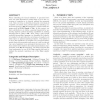966 search results - page 122 / 194 » Code Generation for Embedded Processors |
GLVLSI
2009
IEEE
2009
IEEE
Physical unclonable function and true random number generator: a compact and scalable implementation
14 years 26 days ago
Physical Unclonable Functions (PUF) and True Random Number Generators (TRNG) are two very useful components in secure system design. PUFs can be used to extract chip-unique signat...
PPDP
2005
Springer
14 years 2 months ago
2005
Springer
When addressing the formal validation of generated software, two main alternatives consist either to prove the correctness of compilers or to directly validate the generated code....
VTS
1997
IEEE
14 years 1 months ago
1997
IEEE
Accumulators based on addition or subtraction can be used as test pattern generators. Some circuits, however, require long test lengths if the parameters of the accumulator are no...
SIGMETRICS
1996
ACM
14 years 1 months ago
1996
ACM
This paper describes Embra, a simulator for the processors, caches, and memory systems of uniprocessors and cache-coherent multiprocessors. When running as part of the SimOS simul...
PLDI
2005
ACM
14 years 2 months ago
2005
ACM
Code placement techniques have traditionally improved instruction fetch bandwidth by increasing instruction locality and decreasing the number of taken branches. However, traditio...

